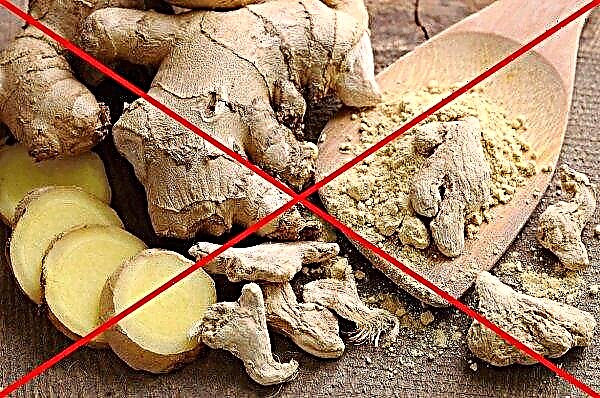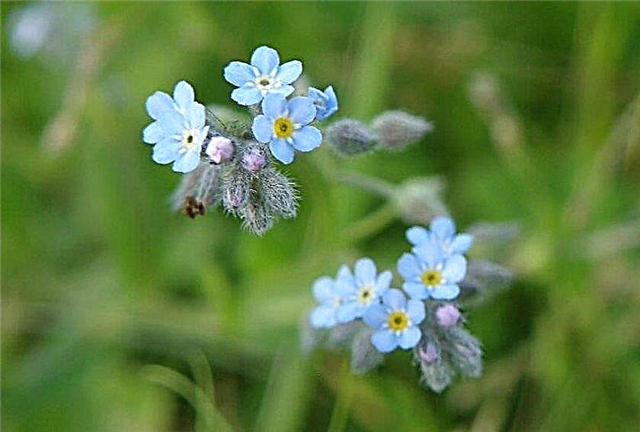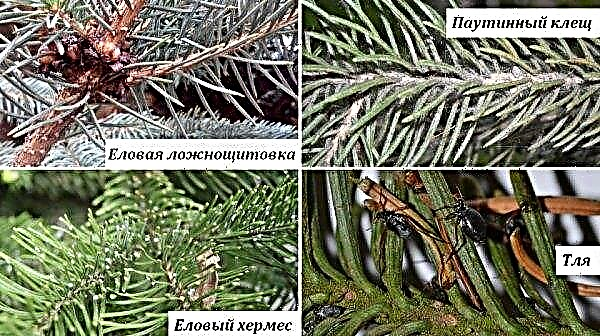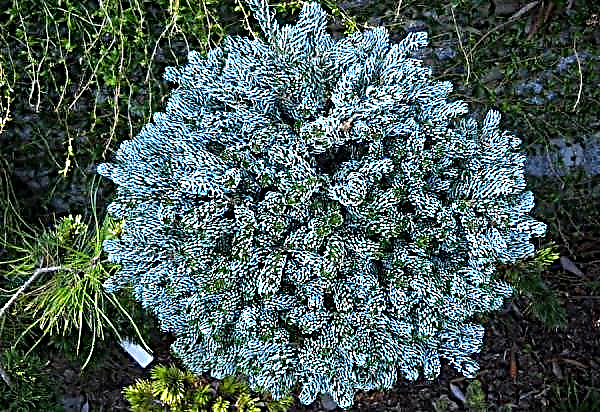If you like attractive inflorescences of magnificent dicentres, then pay attention to the Valentine variety. Its spectacular ruby hearts with a white center on arched stems will add a unique charm to your garden. This plant will remain attractive even after it has finished blooming. For more information on how to grow Valentina, its description and difference from other varieties, read the material.
Description of the hearths Valentine (Valentine)
Dicenter (Lamprocapnos spectabilis) is one of the oldest perennials used in home gardening. The plant was first described by Karl Linney in 1753. He isolated it in a separate taxon (Lamprocapnos) due to its dissimilarity to other plants. The term “spectabilis” in the name means “magnificent” and reflects the emotions that a flowering dicenter evokes in the observer.

Botanical Description:
- family: poppy seeds;
- name: Lamprocapnos spectabilis;
- origin: East Asia;
- area: forest foothills;
- type: bush, deciduous, perennial, fast growing;
- height: 90 cm;
- stems: straight with a vertical habit of growth, thick, branched;
- stems with flowers - arched, leafless, dark burgundy,
- foliage: dense, dark green;
- leaf plate: green at the top, smoky coating at the bottom, smooth, divided into several parts, making it resemble a bird's foot;
- root: fleshy, rod, extending deep into the soil;
- flowers: in the shape of a volumetric heart, arranged in clusters;
- flower diameter: 2 cm;
- flowering period: depending on the climate and variety between May and August, less often from April.
In the spring, long arched floral stems appear at the dicentres. Puffy heart-shaped flowers bloom on them. Their flowering lasts several weeks. Some varieties may bloom 2 times a year.. Even in a cut vase, they are able to maintain their attractiveness for 2 weeks.
Did you know? If the dicenter grows in a temperate (cool climate), then its flowering lasts until the beginning of summer, that is, about a month or more.
What does Valentine look like
The Valentine variety (Dicentra spectabilis Valentine) was obtained as a random seedling from another variety by Phyllis and Lyle Sarrazin from British Columbia (Canada). It features brighter red colors. The shape is similar to other varieties of dicentres with a height of 76–80 cm and a width of up to 90 cm.
Valentina is a long-lived perennial. It flourishes quite well in winter hardiness zones with indicators from 3 to 9 (minimum winter temperature -40 ° C). After bright spring flowering, the plant, as a rule, freezes in the summer, especially if it is very hot and dry. With a lack of moisture, the dicenter can even partially drop the leaves. But with good humidity and moderate temperature, the bush turns green all summer until late autumn.

In spring, when foliage appears, it has a purple hue, and then acquires a more familiar dark green color. In the middle of spring, many long arched flower stems form near the bush. Plump, heart-shaped, bright red with a white tip flowers blooming on them will delight the eye until late spring.
If the buds that have bloomed are not removed, then small seed pods develop instead. In a mature state, they open up and dump seeds on the ground. New shoots will emerge from them next spring. The resulting seedlings are easy to transplant while they are still small, but they may not exactly resemble the parent plant.
Important! The Valentine variety, like all Dicentra spectabilis, slows down when it grows. Gardeners use stimulants to get longer stems. They do not allow the plant to slow down, and also make the flowers more full and attractive.
The variety can be grown both in open ground and in containers.. Some gardeners even practice indoor cultivation. Valentine propagates vegetatively with the help of basal cuttings and division. The variety is patented (USPP22739, COPF) and its vegetative propagation for the purpose of further commercial use is currently prohibited. Nurseries that have manufacturer permission to sell supply root material with 1–4 growth points. Smaller plants are offered for container growing, larger ones for open ground.
The optimal conditions for growing Valentine's variety:
- lighting: partial shadow or full sun;
- soil type: garden, sand and even clay;
- acidity: neutral or alkaline;
- humidity: moderate but persistent;
- exacting care: moderate;
- created for: registration of borders, growing in containers and for cutting.
Video: Dicenter flower - planting and care, growing dicentres from seeds
Night frosts can be a problem for young plants. Especially if there are leaves and young shoots. If frost is expected in spring, then the bushes need to be insulated with dry leaves or a thick layer of mulch.
What are the differences from other varieties
Varietal variety of dicentres mainly varies by flower color. For example, Valentina is a dark red puffy heart with a white tip. Golden dew - golden and narrower. In addition, the Golden Dew is 2–3 times higher than Valentina, since it can reach a height of 3 m. A broken heart has a pinker shade of flowers. Variety Alba in the spring will be decorated with white hearts.
Comparative characteristics of some features of the dicentres:
| Grade | Flowers / Flowering Season | Winter hardiness / lighting | Maximum dimensions (height / width) |
| Amore pink | pink / late spring and re throughout the summer | 5 (-29 ° C) / partial sun | 60 x 60 cm |
| Aurora | white / late spring and re throughout the summer | 3 (-40 ° C) / partial sun | 60 x 60 cm |
| Burning Hearts | dark red / late spring and re throughout the summer | 5 (-29 ° C) / partial sun | 30 x 60 cm |
| Alba | white / late spring or early summer | 3 (-40 ° C) / partial sun | 90 x 90 cm |
| Valentine | bright red / late spring or early summer | 3 (-40 ° C) / partial sun | 90 x 90 cm |
How to plant in open ground
In the natural habitat, the bush grows under the protection of other trees.. And this must be borne in mind when landing it on the site. A bright space with partial shadow is perfect for this. Unlike the constantly scorching sun, gliding rays are not a problem. But a systematic stay in an open area can cause sunburn and wilting.
Plant bushes in places protected from strong winds and early frosts. This may be the outskirts of gardens, where other trees cover the wind from the windsurfing center. Near the buildings, it is recommended to plant a bush on the north or east side.
Important! All parts of the dicentres, when ingested, cause severe abdominal pain. And the leaves themselves can cause a skin allergic reaction.
Rich, loose, evenly moist, but well-drained soil suits Valentina.. During planting, to improve nutrition, it is recommended to add compost, humus or peat moss to it in large quantities in order to improve the soil's ability to retain moisture and increase nutrition. Very heavy clay soil needs to be diluted, because it is not entirely favorable for the development of shrubs.
Planting of roots acquired in the nursery is carried out in early May or late April. The landing site is dug up to the depth of the bayonet shovel. Then prepare the pit. Its size can be from 0.4 to 0.5 m in width and in depth. When planting several plants, the distance between them will be 0.5 m. The same distance is left between the bush and the walls of buildings or other obstacles.

Landing Instructions:
- At the bottom of the pit drainage is laid. It can be crushed stone, broken brick, pebbles.
- The soil removed from it is mixed with peat, compost or humus. This is important to increase the looseness of the soil, and to increase its nutritional value. If the soil is too heavy and clay, then you can add sand.
- Part of the mixture is poured onto the drainage layer.
- From above establish a plant.
- Add soil mixture.
- Seal around the trunk. Watered.
- The root zone is covered with mulch. It can be sawdust, needles, wood chips, straw and other materials. Such a layer prevent the rapid evaporation of moisture from the soil and the growth of weeds.
Video: Planting and care of the center
What time to land
Shrub planting is best planned in the spring. There are a number of objective reasons for this:
- firstly, you do not know the quality of the material that will be received from the nursery;
- secondly, the roots will not only have time to take root, but also begin to develop the plant before winter;
- in addition, the flower is very sensitive to nocturnal soil frosts.
Autumn planting is carried out only in warm regions, where the root system has a longer development period and manages to develop well by the onset of winter.
Did you know? In Greek, the name of the plant stands for "double-spore": "Dis" — two, kentron — spur. The corolla petals are bent up and resemble a spur.
Plant care
The plant can be planted in open ground or grown in pots to decorate terraces and balconies. The center is unpretentious, however, there are several points that you need to keep in mind in order for the seedling to turn into a magnificent bush.
The plant will need:
- periodic watering;
- fertilizer application;
- loosening the soil and removing weeds;
- prevention and control of pests and possible diseases;
- autumn shrub care with removal of fallen leaves and digging the soil.
And when it becomes too large, a transplant may be required with simultaneous division into two or more small bushes.

Watering
Soil for Valentina should not be either excessively wet or dry. Therefore, watering is carried out taking into account how quickly the soil dries. If you visually see that the earth does not contain moisture - water. Avoid swamping to rule out the possibility of root rot.
Fertilizer
Add 5-7 kg of compost for each bush in early spring. Do not forget that after applying fertilizers, you must definitely water the land abundantly. Organic dressings are slow-release, so it’s enough to apply 1-2 times per season. The second time you can fertilize those varieties that bloom twice. Plan feeding for early July or late June.

Pruning
Trimming the dicenter is optional. This weakens the plant. An exception is the removal of flowers that have faded. They are cut off when the foliage on these shoots is completely dry. If the parts of the branch are still green - do not touch. This means that the plant still receives from the leaves the nutrients that it needs to prepare for wintering. The length of the trimmed part is about 15 cm.
Did you know? Japan is considered to be the birthplace of the center. It is from there that most of its varieties come from.
Care after flowering
A special moment in the annual cycle of the shrub is that its leaves can die off after the bush has faded and a hot summer has come. Therefore, along with it, plants are planted in the flower garden that will support the presentable appearance of the site. It can be low-growing perennials. For example, ferns. They also love partial shade, like the main plant, and are suitable for cultivation in winter hardiness zones from 3 to 9.
If there is a desire to propagate to the dicenter, then the branches cut off after flowering can be put in water so that they let the roots. And then plant in pots filled with a mixture of sand and humus. At first they will grow indoors. And in the spring they can be transplanted into the garden.

Does it winter and how to prepare for winter
At the end of the season, in the fall, you need to remove fallen leaves. The root zone is covered with mulch as soon as the air temperature drops below 0 ° C. It will serve as an insulating layer. Mulch prevents sudden fluctuations in soil temperature during the thaw and subsequent freezing.
Seed collection
When the seed capsules begin to ripen, they change color and become pale yellow-brown.. For collection, choose a dry sunny day. Pods are torn off and laid out in a room for drying.

You can use a warm sunny window sill or electric dryer. Dry seed boxes then gently open and release the seeds. Leave to dry for a couple more days. And then put in a paper bag for storage.
Do not leave seeds with parts of pods. Phytopathogens, including mold, can settle on plant tissues. Desiccants (silica gel, moisture-absorbing tablets) are recommended to be placed in the seed bag to remove excess moisture.
Important! If you are going to propagate to the dicenter, it is better to immediately put the seeds in a container with soil for stratification, i.e., as they are stored, their germination capacity drops sharply.
Reproduction dicentres
The plant can propagate by cuttings or by dividing the bush. Cuttings are made by cutting one of the branches on a frosty autumn day. It is neatly divided into parts of 5-7 cm long. Each is dipped in a growth promoter, for example, in Kornevin, and planted in a substrate of compost and sand. The soil is regularly moistened. Rooting cuttings takes about 3 weeks. Then they are transferred to a room with a temperature of + 12 ° C. You can plant them on the street in May.
Division of the bush is carried out in the spring.. For this, it is carefully dug. Remove along with part of the soil. Using a knife, divide into 2 parts so that each has approximately the same number of points for growth. For planting, 2 new pits are prepared and divisions are planted there.

Dicenter can also be propagated by seeds. To do this, they need to be collected before the seed pods are opened, and dried in a room on a sheet of paper. Plant seeds need stratification, i.e. cold treatment. To do this, prepare a container with peat, moisten it. Seeds are placed on top and left in the refrigerator on the bottom shelf. The soil in the container should remain moist at all times.

Store seeds this way for at least 6 weeks. Then they are taken out and sown in pots with compost and sand. Pots are left indoors at a temperature of + 12 ° С ... + 15 ° С. As soon as the seedlings germinate, the temperature is raised to + 20 ° C. After 2-3 true leaves appear, the temperature is again slightly reduced. Throughout the entire period, soil moisture is necessarily controlled. Seedlings are planted in the beds when spring comes.
Important! Gardeners recommend to divide the roots of varieties with fringed leaves in early spring, and with red flowers — after they fade.
Diseases and pests
The main problem that arises in dicenters is root rot.. The disease contributes to the lack of water drainage from the roots and too abundant watering. The diseased plant has soft, darkened roots that emit an unpleasant odor. Such roots are removed, the root system is treated in a pale pink solution of potassium permanganate for 30 minutes, and then in "Kornevin", which is diluted in accordance with the instructions for the drug. Then planted in a new place.
Warm and humid weather contributes to garden aphids. These insects infect any plants. They settle in colonies on young shoots. In the process of feeding, the aphid emits a sticky sweet coating. Sooty fungi may appear on it later. They form a black coating on the leaves, which is dangerous because it impedes the process of photosynthesis. Under it, parts of the plant may die. Aphids are destroyed by spraying the bush with a solution of insecticidal soap (15 g / 1 l of water). This tool also helps with thrips, which also do not tolerate this tool.
 Vole mice are no less dangerous for the bush.To protect against them, young plants are planted inside a mesh basket. The diameter of the cells should be such that the mice cannot get through them to the bush
Vole mice are no less dangerous for the bush.To protect against them, young plants are planted inside a mesh basket. The diameter of the cells should be such that the mice cannot get through them to the bush
With proper planting and creating optimal conditions for the development of the center, you will be pleased with beautiful clusters of flowers every spring. It grows well both in containers and in open ground. Given its high decorativeness and undemanding conditions for development, we can recommend the plant for growing everywhere on any soil and in most climatic regions.












